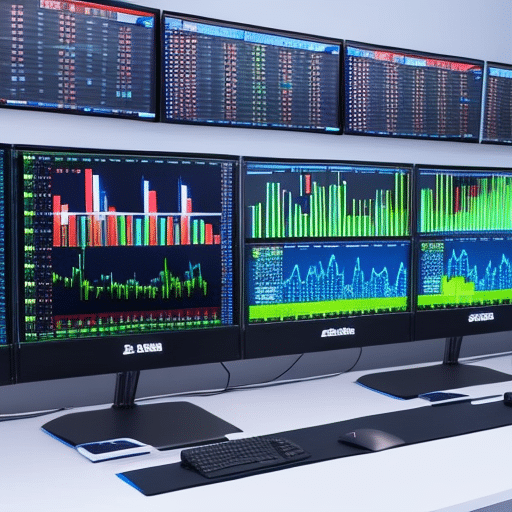Are you ready to unlock your crypto trading success? If so, mastering the best indicators is crucial. These powerful tools protect you from losses and help you make informed decisions in the volatile market. Whether you’re a day trader or swing trader, understanding different types of trading indicators is essential. Trend indicators like Ichimoku Cloud and trendlines determine market direction, while momentum indicators like RSI and Stochastic Oscillator assess market changes. Volatility indicators like Bollinger Bands measure market volatility, while volume indicators like On-Balance Volume provide insights into market activity. Let’s dive in and master the best indicators for your crypto trading success.
Table of Contents
ToggleTypes of Trend Indicators
First, let’s explore three types of trend indicators that can help you navigate the crypto market successfully. Trend indicators play a crucial role in determining the direction of the market trend. The first type is the Ichimoku Cloud, which provides support and resistance levels, as well as momentum signals. It consists of several lines that together form a cloud, indicating potential trend changes. The second type is trendlines, which are drawn to connect consecutive highs or lows. These lines help identify the overall trend and provide entry and exit points. Lastly, moving averages are widely used trend indicators. They smooth out price data and help identify the direction of the trend. Shorter timeframes require faster moving averages, while longer timeframes require slower ones. By understanding and utilizing these trend indicators, you can make informed decisions in the crypto market.
Momentum Indicators for Assessing Market Changes
To assess market changes effectively, utilize momentum indicators that provide valuable insights into price movements and potential reversals. These indicators help traders gauge the strength and speed of a trend, allowing them to make informed decisions in their trading strategies. Here are some key points to understand about momentum indicators:
- Stochastic Oscillator (SO): Measures momentum strength in a trend by comparing the current closing price to the price range over a specific period.
- Ichimoku Cloud: Shows support, resistance, and momentum based on a combination of moving averages and plotted lines.
- Bollinger Bands: Measures market momentum and identifies overbought or oversold conditions by analyzing price volatility.
- Relative Strength Index (RSI): Determines overbought or oversold conditions by comparing recent gains and losses.
Volatility Indicators for Determining Market Volatility
How can you accurately determine market volatility and make informed trading decisions? Volatility indicators play a crucial role in assessing market volatility and guiding your trading strategy. These indicators help identify periods of high or low volatility, allowing you to adjust your trading approach accordingly. One popular volatility indicator is the Bollinger Bands. These bands consist of a moving average line and two standard deviation lines, which expand during periods of high volatility and contract during low volatility. By monitoring the width of the bands, you can gauge the intensity of market movements and anticipate potential breakouts or reversals. Another useful volatility indicator is the Average True Range (ATR), which measures the average range between high and low prices over a specific period. A higher ATR indicates higher volatility, while a lower ATR suggests lower volatility. By incorporating these volatility indicators into your trading analysis, you can better navigate the dynamic crypto market and enhance your trading success.
Volume Indicators for Analyzing Market Activity
To analyze market activity effectively, you can utilize volume indicators that provide insights into the number of deals and buying/selling pressure in the crypto market. These indicators are essential tools for traders seeking to understand market dynamics and make informed trading decisions. Here are four key points about volume indicators:
- Volume indicators help gauge the level of market participation and the intensity of buying or selling pressure.
- On-Balance Volume (OBV) is a popular volume indicator that tracks the cumulative volume to identify trends and potential reversals.
- Volume Profile Indicator displays the trading activity of a cryptocurrency over time, showing the most traded price levels and volume distribution.
- The Volume indicator can confirm or contradict other technical indicators, providing additional confirmation for trading signals.
Oscillators for Identifying Market Swings
You frequently use oscillators to identify market swings and make informed trading decisions. Oscillators are technical indicators that fluctuate within a specific range, helping you determine overbought and oversold conditions in the market. By measuring the momentum and speed of price movements, oscillators can provide valuable insights into potential trend reversals. One commonly used oscillator is the Relative Strength Index (RSI), which compares the magnitude of recent gains to recent losses. When the RSI reaches extreme levels, it suggests that the market is overbought or oversold, indicating a potential reversal in price. Another popular oscillator is the Stochastic Oscillator, which measures the current price relative to its range over a specified period. By identifying overbought and oversold levels, the Stochastic Oscillator helps traders anticipate trend changes and market swings.
Understanding Moving Averages (MA)
To fully grasp the concept of Moving Averages (MA), it is essential for you, as a crypto trader, to consistently incorporate these indicators into your trading strategy. Moving averages analyze market trends and sentiment, helping you identify established trends. Different types of moving averages serve specific purposes, with shorter timeframes requiring faster moving averages like MA 9, and longer timeframes requiring slower moving averages like MA 200. Moving averages are calculated differently depending on the type. The Simple Moving Average (SMA) is commonly used for trend determination, while the Smoothed Moving Average (SMMA) filters out market noise. The Exponential Moving Average (EMA) prioritizes recent data, and the Weighted Moving Average (WMA) prioritizes data using a multiplier. By understanding and utilizing moving averages effectively, you can make more informed trading decisions in the volatile crypto market.
Different Types of Moving Averages
Moving Averages are calculated differently depending on their type, serving specific purposes in analyzing market trends and sentiment. There are four main types of moving averages: Simple Moving Average (SMA), Smoothed Moving Average (SMMA), Exponential Moving Average (EMA), and Weighted Moving Average (WMA). The SMA is commonly used for trend determination and calculates the average price over a specific period. The SMMA filters out market noise by applying a smoothing technique. The EMA prioritizes recent data and gives more weight to the most recent prices. The WMA prioritizes data using a multiplier, giving more weight to certain periods. Each type of moving average has its own advantages and disadvantages, and traders should choose the one that best suits their trading style and timeframe.
Using Moving Averages to Identify Trends
By analyzing different types of moving averages, you can effectively identify trends in the crypto market. Moving averages are powerful tools that help traders understand the direction of the market and make informed trading decisions. Here are four key points to consider when using moving averages to identify trends:
- Moving averages help smooth out price fluctuations and provide a clearer picture of the overall trend.
- Shorter timeframes require faster moving averages, such as the MA 9, to capture rapid market movements.
- Longer timeframes require slower moving averages, like the MA 200, to filter out noise and identify more stable trends.
- Different types of moving averages, including the Simple Moving Average (SMA), Smoothed Moving Average (SMMA), Exponential Moving Average (EMA), and Weighted Moving Average (WMA), offer different benefits and cater to specific trading strategies.
Shorter Timeframes and Faster Moving Averages
Maximize your trading efficiency with shorter timeframes and faster moving averages. When trading in shorter timeframes, such as intraday or scalp trading, it is essential to use moving averages that react quickly to market movements. Faster moving averages, like the 9-period moving average (MA 9), are ideal for identifying short-term trends and capturing quick price movements. These moving averages are calculated based on recent data, allowing you to stay updated on the latest market conditions. By using faster moving averages, you can make timely trading decisions and capitalize on short-term opportunities. Remember to adjust your moving average settings according to your preferred timeframe and trading strategy, as the choice of moving average can greatly impact your trading success in shorter timeframes.
Longer Timeframes and Slower Moving Averages
To achieve greater accuracy in analyzing long-term trends and capturing significant price movements, slower moving averages are essential for traders operating in longer timeframes. Slower moving averages smooth out short-term price fluctuations and provide a clearer picture of overall market direction. Here are four key reasons why slower moving averages are beneficial for longer timeframes:
- Reduced noise: Slower moving averages filter out market noise and focus on the underlying trend, enabling traders to make more informed decisions.
- Enhanced trend identification: Slower moving averages help identify established trends by providing a smoother line that reflects the overall market direction.
- Stronger support and resistance levels: Slower moving averages can act as reliable support or resistance levels, providing valuable insights into potential price reversals.
- Higher probability trades: By using slower moving averages, traders can enter trades with higher probability of success as they align their positions with the dominant trend.
Exploring Different Calculations for Moving Averages
When exploring different calculations for moving averages, you can gain a deeper understanding of market trends and improve your trading success. Moving averages serve as essential indicators for analyzing market sentiment and identifying established trends. Different types of moving averages are calculated differently to suit specific purposes. The Simple Moving Average (SMA) is commonly used for trend determination, while the Smoothed Moving Average (SMMA) filters out market noise. The Exponential Moving Average (EMA) prioritizes recent data, and the Weighted Moving Average (WMA) assigns a multiplier to prioritize specific data points. By utilizing these different calculations, you can effectively analyze market patterns and make more informed trading decisions. Understanding the nuances of each moving average calculation allows you to adapt your trading strategy to different timeframes and market conditions, ultimately enhancing your trading performance.
MACD Indicator for Complex Analysis
To analyze market trends and make informed trading decisions, incorporate the MACD indicator for complex analysis. The MACD (Moving Average Convergence / Divergence) indicator is a powerful tool that consists of the oscillator, signal line, and histogram. Here are four key points to understand about the MACD indicator:
- MACD line crossing the signal line indicates a new trend.
- Divergence between MACD and price can provide early signals for catching trends.
- Divergence occurs when price and MACD show opposite movements.
- By identifying trend changes and divergences, the MACD indicator helps traders make timely and profitable decisions.
Incorporating the MACD indicator into your trading strategy can enhance your ability to identify potential trend reversals and profit from market movements.
Components of the MACD Indicator
Now let’s delve into the components that make up the MACD indicator, allowing you to further analyze market trends and make informed trading decisions. The MACD (Moving Average Convergence/Divergence) indicator consists of three main components: the MACD line, the signal line, and the histogram. The MACD line is calculated by subtracting the 26-day exponential moving average (EMA) from the 12-day EMA. This line represents the difference between the two moving averages and helps identify changes in trend direction. The signal line, also known as the trigger line, is a 9-day EMA of the MACD line. It acts as a signal for potential buying or selling opportunities. The histogram is derived by subtracting the signal line from the MACD line. It provides visual representation of the difference between the two lines and indicates the strength of the trend. By understanding these components, you can effectively utilize the MACD indicator in your trading strategy.
Using MACD for Trend Identification and Divergence Trading
To effectively utilize the MACD indicator in your trading strategy, understanding its components allows you to identify trends and engage in divergence trading. The MACD indicator consists of the oscillator, signal line, and histogram. Here’s how you can use MACD for trend identification and divergence trading:
-
Trend Identification: When the MACD line crosses above the signal line, it indicates a new bullish trend. Conversely, when the MACD line crosses below the signal line, it indicates a new bearish trend.
-
Divergence Trading: Divergence occurs when price and MACD show opposite movements. Bullish divergence happens when price makes lower lows while MACD makes higher lows. This suggests a potential reversal to the upside. On the other hand, bearish divergence occurs when price makes higher highs while MACD makes lower highs, indicating a potential reversal to the downside.
Other Powerful Trading Indicators for Success
Explore additional trading indicators that can enhance your crypto trading success. In addition to the MACD indicator, there are several other powerful indicators that can provide valuable insights into the market. The Stochastic Oscillator (SO) measures momentum strength in a trend, helping you identify overbought and oversold conditions. The Ichimoku Cloud shows support, resistance, and momentum, giving you a comprehensive view of the market. Bollinger Bands measure market momentum and indicate overbought or oversold conditions. The Relative Strength Index (RSI) determines when an asset is overbought or oversold. Fibonacci Retracement plots support and resistance levels on a price chart, allowing you to identify potential reversal points. The On Balance Volume (OBV) indicator identifies market trends and buying/selling pressure. The Aroon Indicator (ARN) assesses trend strength and potential reversals. The Average Directional Index (ADX) measures the strength of a trend. The Awesome Oscillator (AO) is a momentum indicator developed by Bill Williams. The Volume Profile Indicator displays the trading activity of a cryptocurrency over time. Lastly, the Momentum Indicator (MOM) compares the current price to a predetermined number of periods ago, giving you a sense of the asset’s momentum. By using these additional indicators, you can gain a deeper understanding of the market and make more informed trading decisions.
Frequently Asked Questions
What Are Some Frequently Asked Questions About the Stochastic Oscillator (So)?
The Stochastic Oscillator (SO) is a frequently asked about indicator. It measures momentum strength in a trend. Traders often inquire about how to interpret overbought and oversold conditions using the SO.
How Does the Ichimoku Cloud Indicator Show Support, Resistance, and Momentum?
The Ichimoku Cloud indicator shows support, resistance, and momentum by plotting multiple lines on a price chart. It identifies key levels where prices are likely to reverse and provides a visual representation of market trends and volatility.
What Are the Commonly Used Indicators to Determine Overbought or Oversold Conditions?
To determine overbought or oversold conditions, commonly used indicators include the Relative Strength Index (RSI), Stochastic Oscillator (SO), and Bollinger Bands. These indicators help you identify potential market reversals and make informed trading decisions.
How Does the Fibonacci Retracement Indicator Plot Support and Resistance Levels on a Price Chart?
The Fibonacci retracement indicator plots support and resistance levels by using key Fibonacci ratios as potential reversal areas. These levels are drawn based on the previous price swing, helping you identify potential entry and exit points on a price chart.
What Does the Volume Profile Indicator Display and How Does It Help Analyze Trading Activity of a Cryptocurrency?
The volume profile indicator displays the trading activity of a cryptocurrency over time. It helps you analyze the distribution of volume at different price levels, identifying areas of high and low liquidity for potential trading opportunities.





















